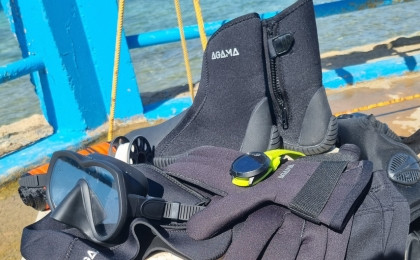How to choose the right neoprene gloves
7. 2. 2024
If you are considering buying neoprene gloves, we have some advice on how to choose the right size, thickness and type.
If you are a fan of water sports such as diving, hardening, winter swimming, kiteboarding, wakeboarding, paddleboarding and others, then neoprene gloves are an essential accessory for you.
During swimming or diving in extremely cold conditions, the hands and feet are the most sensitive to heat loss, as the vital organs get priority over their blood supply, so the limbs should be thermally protected with high-quality neoprene gloves. In our offer you will find neoprene gloves of excellent quality, in different thicknesses and elasticity.
Main features of neoprene gloves:
- Thermal insulation - neoprene material is optimal due to its excellent thermal insulation properties. It is a flexible rubber material with a foam structure. Neoprene material is impermeable, but water always gets through the edges and seams. Contact with water and heat from our body then causes the water to heat up, gaining insulating properties and preventing possible cold from cold water.
- Elasticity and flexibility - neoprene is an elastic material, which gives the gloves high elasticity and flexibility. This allows comfortable hand movements, which is especially important during sports activities such as surfing or diving.
- Abrasion protection - neoprene gloves provide protection against abrasion and reduce the risk of abrasions or injuries when handling water equipment or in more demanding environments where there is a risk of abrasion on rocks or corals.
Neoprene gloves are also produced in combination with Kevlar. The palms and fingertips are often the most stressed parts of neoprene gloves, and that is why these parts are protected by Kevlar, which has a high resistance to abrasion. Kevlar gloves are especially suitable for professional and technical diving and activities where the gloves will be more stressed.
To secure the gloves more firmly, some types of neoprene gloves have a tightening strap or anti-slip coating, which is especially appreciated by paddlers and paddleboarders when holding a paddle.
Size of neoprene gloves:
Correct sizing is key to comfortable and effective use of neoprene gloves. Gloves that are too tight can prevent normal blood flow to the hands, and loose gloves are an invitation for water to get inside. Measuring the circumference of your palm will help you choose the ideal size, ensure the right fit and optimal protection.
The right choice of neoprene glove thickness:
We rank neoprene gloves among the basics of water equipment, which offer not only thermal comfort and protection against abrasion, but also flexibility for various water activities. The chosen thickness of the gloves plays a decisive role in how well they will meet specific conditions.
- Gloves with a thickness of 1.5 mm - 2 mm - such gloves are ideal for warmer waters and active sports such as swimming, snorkeling or diving in tropical areas. Their low profile allows for maximum mobility and sensitivity, which is key for these water activities.
- Gloves with a thickness of 3 mm - this thickness is suitable for universal use in a wider range of conditions. It is great for activities in moderately warm waters and is durable enough for regular water sports. It provides a balance between thermal insulation and flexibility.
We recommend neoprene gloves with a thickness of 1.5 - 3 mm as neoprene gloves for hard workers. However, it always depends on each individual's sensitivity to cold and individual preferences.
- Gloves with a thickness of 4 mm - 5 mm - for colder waters and more extreme conditions, such as winter surfing or diving in colder seas. These models provide significant thermal insulation and protection from the cold.
- 6.5 mm gloves - for extreme conditions, in areas with icy water, 6.5 mm gloves are the ideal choice. They provide excellent thermal insulation, albeit at the expense of flexibility. They are especially suitable for professional surfers or divers in extremely low temperatures.
Effect of neoprene gloves on mobility:
The thinner the neoprene gloves, the more mobility they provide. Thicker gloves provide better thermal insulation, but may limit flexibility. When choosing, it is important to find the optimal balance according to specific needs and conditions.
Other uses of neoprene gloves:
As already mentioned, neoprene gloves for cold water have a very wide range of uses. They can be used for all water sports, including fishing, motorcycling and wherever you need to warm up your hands and keep them warm.
The best-selling types from our offer are neoprene gloves Agama ULTRASTRETCH 3.5 mm and Aropec CLASSIC 5 mm.






